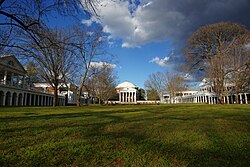The Lawn
|
University Of Virginia Historic District
|
|

The Lawn in winter of 2010, looking north
|
|
| Location | Bounded by University and Jefferson Park Aves., and Hospital and McCormick Rds., Charlottesville, Virginia |
|---|---|
| Coordinates | 38°2′5″N 78°30′15″W / 38.03472°N 78.50417°WCoordinates: 38°2′5″N 78°30′15″W / 38.03472°N 78.50417°W |
| Area | 35 acres (14 ha) |
| Built | 1817 |
| Architect | Thomas Jefferson; Stanford White |
| Architectural style | Early Republic |
| NRHP Reference # | 70000865 |
| VLR # | 104-0042 |
| Significant dates | |
| Added to NRHP | November 20, 1970 |
| Designated NHLD | November 11, 1971 |
| Designated VLR | October 6, 1970 |
The Lawn, a part of Thomas Jefferson's Academical Village, is a large, terraced grassy court at the historic center of Jefferson's academic community at the University of Virginia. The Lawn and its surrounding buildings, designed by Jefferson, demonstrate Jefferson's mastery of Palladian and Neoclassical architecture, and the site has been recognized as an architectural masterpiece in itself. The Lawn has been designated a U.S. National Historic Landmark District, and is part of a UNESCO World Heritage Site along with the original buildings of the University of Virginia and Monticello, Jefferson's nearby residence; this designation is due to the site's architectural and cultural significance.
Jefferson originally designed the Lawn to be the center of the university, and as such it is surrounded by housing for students and faculty. Its most famous building is the Rotunda, which sits at the north end of the site, opposite Old Cabell Hall. Framing the other two sides of the Lawn are ten Pavilions, where faculty reside in the upper two floors and teach on the first, as well as 54 Lawn rooms, where carefully selected undergraduates reside in their final year. Opposite the Pavilions and Lawn rooms are ten gardens, and similar to the Pavilions, each garden is designed in a distinct way; no two gardens are the same. The outermost row of buildings on either side constitute the edge of the Academical Village; these are known as the Range and house graduate students.
The Lawn has remained the symbolic center of the university since 1819, when the university was founded. It annually serves as the site of the university's graduation ceremonies, as well as other ceremonies during the year.
...
Wikipedia

